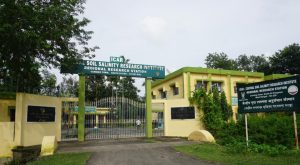
About Centre
The Regional Research Station, Canning Town is located right on the climatically vulnerable coastal region of Ganges delta to cater the research and management needs of coastal salt affected soils. The research station is geographically situated at 22o15’N latitude and 88o40’E longitude is at about 46 km south –east of Kolkata. The station at canning Town was established in 1959 when it was under the administrative control of the then Central Rice Research Institute (CRRI), Cuttack. Later, after the establishment of CSSRI in 1969 the Research Station was brought under the aegis of CSSRI in 1970 as its Regional Research station. This station has developed several technologies for enhancement of agricultural (agriculture + fisheries) productivity under degraded (saline) coastal soils and poor water (saline) qualities. Some of these technologies are based on land shaping to alleviate the issues of water- logging and increased salinity of soil in coastal area. Several salt-tolerant crops/varieties and management practices have been developed/introduced for multiple and diversified cropping system in the mono cropped area. Agriculture aquaculture integrated farming system, improved techniques for increasing water use efficiency etc. have been developed which may be some of the key technologies for climate change adaptation. The station has a campus of an approximate area of 26 hectare of land on the bank of the estuarine river Matla. It has 3 adjacent units viz. Laboratory/ Office, residential quarters and experimental farm.
Building
Regional Research Station, Canning Town has two main buildings units, one is for administrative offices and the other for modern research laboratory. Besides there are other buildings viz. Workshop, Stores, Meteorological Observatory, Glass House and residential quarters
Farm
Out of the total 26 hectare of land about 12 hectare is old experimental farm area and about 14 hectare is the new experimental farm area located on the silted bed of the estuarine river Matla flowing brackish water round the year. The farm is equipped with modern farm machineries and facilities like tractor, power-tillers and diesel engine pumps, electrical pumps, drip irrigation system and micro-sprinkler irrigation system, irrigation ponds, deep-tubewells, etc.
Laboratory
The building has different laboratory units like Soil Physics, Soil Chemistry, Agricultural Engineering, Agricultural Extension, Agricultural Economics, Plant Breeding, Agronomy and Plant Physiology.

The laboratories are well equipped with the instruments such as Atomic Absorption Spectro Photometers (AAS) (Fig.2), UV-Spectrophotometer, Automatic Nitrogen Analyzer, Flame Photometer, Electronic Digital Balances, Pressure Plate Apparatus, Neutron Probe-moisture meter, digital pH Meters, digital Conductivity Meters, ODR Meter, Water level indicator, Lysimeter, Dumpy level, Pantograph, Deep-freeze, Centrifuge, GPS, etc. The computers of the laboratories are connected trough LAN. There are advance facilities like Internet system through VSAT, data loggers, scanners, LCD Projector, Handy cam, Digital Camera, etc.
Meteorological observatory
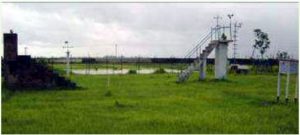
The meteorological observatory of the Regional Research Station is having all the necessary equipments for measuring standard weather parameters (Fig.3). Trained and experienced staff members of this station and IMD are engaged for recording and communicating the daily
Library and Seminar Room
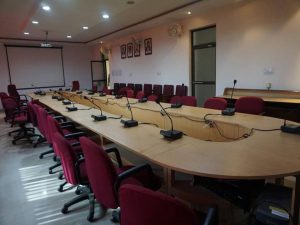
Library: The library subscribes 14 journals of national and international repute. Currently the library holds 1487 books, periodical and reports. Seminar Room: The station has a well equipped committee room with audio-visual facilities
Museum
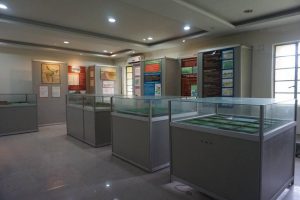
Museum: The station has a well designed museum (Fig.6) for exhibiting the technologies developed for management of coastal salt affected soils. Scaled models of different land shaping techniques are also displayed in the museum.
Achievements:
- Soil Management
Characterization of coastal soils: Coastal soils of eastern coast perticulerly of West Bengal and Orrisa have been studied. Coastal soils of West Bengal (in the Ganges delta) are classified under different pH and salinity (Fig.4) groups. These soils are usually near neutral in reaction with varying salinity levels. The soil salinity shows highly temporal and spatial variability. The available nutrient status of the soils are: low in N, medium to high in P, high in K and micronutrients except Zn.
The soils are rich in soluble salts of Cl, Na+, Ca2+ and Mg2+ and K+ . The soils are usually heavy to medium in texture with moderate CEC and water holding capacity. The lands are gently sloped and typically characterized by its higher soluble salt contents in the rhizosphere, presence of brackishwater aquifer at close proximity to the surface and poor drainage condition. The soils are, in general, classified as Inceptisol and Entisol in the order level. Based on soil characteristics the location specific management.
Management of acid sulphate soil: Acid sulphate/ acid saline soils are present in the delta region of several major rivers in the coastal areas. These soils are highly under-utilized. Besides liming, higher doses of P-fertilizer is essential for proper management of these soils. Rock phosphate or locally available oyster shell (available in coastal region) along with green manures/ leaf manures may be used for achieving higher yield of crops on these soils.
- Nitrogen management of soil: Volatilization loss of applied N-fertilizer is high in coastal salt affected soils and accounts for a loss as high as 30-50%. Loss of N increases with salinity and loss could be substantially reduced by placement (5cm) of N-fertilizer in soil either directly or in paper packet or in the form of briquettes. The efficiency of N-fertilizer is much improved on using it in conjunction with manures/green manures or any locally available organic materials such as leaves of trees, farm waste, etc.
- Phosphorous and potassium management of soil: The coastal soils are generally rich in available P and K. Long-term experimental results indicated that even if there is no response of P-fertilizer a basal application of 6-11 kg P ha-1, depending on crop type is required to maintain P-fertility level of soils. Application of K-fertilizer, which is mainly imported commodity, may generally be omitted.
- Integrated nutrient management (INM):
The results of on-farm (Fig.5) and experimental field trials conducted simultaneously in West Bengal, Orissa, Andhra Pradesh. and Tamil Nadu, indicated that 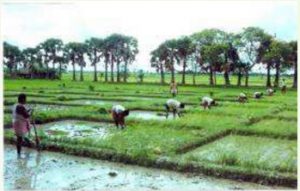 yield of crops was better when combined sources (organic and inorganic) of nitrogen were applied. Addition of Sesbania, Gliricidia, city compost and leaves of locally available trees alongwith inorganic N-fertilizer improved crop yield and soil health. Use of bio-fertilizers particularly for rabi/ summer crops was quite beneficial.
yield of crops was better when combined sources (organic and inorganic) of nitrogen were applied. Addition of Sesbania, Gliricidia, city compost and leaves of locally available trees alongwith inorganic N-fertilizer improved crop yield and soil health. Use of bio-fertilizers particularly for rabi/ summer crops was quite beneficial.
- Managing the damage of rabi/summer crops due to heavy showers: Extensive damages of crops due to heavy showers in rabi/summer are one of the great hindrances for second crop cultivation. Reduce oxygen diffusion in rhizosphere soil and excess availability of Fe in soil are the root causes of damage. Aerating soil between rows through raking, providing drainage and higher dose of P-fertilizer can alleviate the damage.
- Managing salinity build up in soil: Strategies like growing crops with large foliage cover, mulching with rice husk/ rice straw or any organic waste are very effective to decrease large accumulation of salts during dry season.
- Managing rice field against toxic gases: Formation of hydrogen sulphide (H2S) gas due to sulphate reduction may lead to low rice yield and environmental pollution. Occasional stirring of rice soil in between rows will release H2S in air and reduce crop damage.

In case of acute damage of crop due to H2S excess Fe-fertilizer may be applied. A simple estimation for H2S released from rice field was developed as shown given in Fig.6. Production of methane (CH4) in rice field causing environmental pollution was found to reduce by application of Calcium Carbide encapsulated N-fertilizer.
- Changes in coastal land following introduction of brackishwater fisheries: In the recent years large areas of agricultural fields in the coastal areas of the country, particularly in the state of West Bengal are being converted into brackishwater fish and prawn farms for higher remunerations. It was observed that due to the brackish water fisheries the soil salinity of adjacent crop fields increased and there was a decrease in yield. The influence was prominent up to a distances of 50 m. The soil salinity of brackishwater fish farm also increased with the increase in the salinity of water. Available iron and manganese content in soil was quite high in the adjoining crop fields and more so in the brackishwater fish farms. When a brackishwater fish farm was reconverted to agricultural fields, the oxidation of sulphidic materials in soil may produce high acidity and toxic availability of Fe, Al and Mn
- Water Management
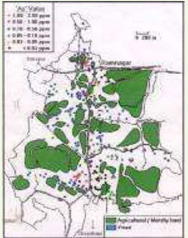 Managing arsenic contaminated water for irrigation: Ground water at shallow depth (<125 ft) at many locations in Baruipur block, (in coastal West Bengal) South 24 Parganas contains toxic levels of As (0.05-2.5 ppm), while surface water and underground water at depth >250 ft are usually free from arsenic (Fig 7.). Consumption of crops, particularly root crops and leafy vegetables grown on arsenic affected soil/water is harmful for human health. Soil rich in arsenic should be additionally fertilized with Fe or Zn to induce arsenic fixation, while application of P-fertilizer, organic manures and submergence of soil should be
Managing arsenic contaminated water for irrigation: Ground water at shallow depth (<125 ft) at many locations in Baruipur block, (in coastal West Bengal) South 24 Parganas contains toxic levels of As (0.05-2.5 ppm), while surface water and underground water at depth >250 ft are usually free from arsenic (Fig 7.). Consumption of crops, particularly root crops and leafy vegetables grown on arsenic affected soil/water is harmful for human health. Soil rich in arsenic should be additionally fertilized with Fe or Zn to induce arsenic fixation, while application of P-fertilizer, organic manures and submergence of soil should be
 Irrigation with tubewell water:
Irrigation with tubewell water:
Water of some of the shallow tubewells in Sunderbans region was found suitable (EC <2 dSm-1) for irrigation. Economic analysis indicated marginal profit from rabi/summer paddy cultivation irrigated with the tube-wells (Fig.8.) The economics of water use could be increased by cultivating crops other then paddy, which require less water
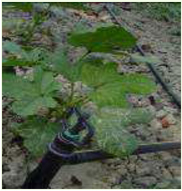 Growing crops under micro-irrigation systems: Ladies’ finger yielded more under drip irrigation at IW/CPE ratio 1.0 than IW/CPE ratio 0.5 and conventional method. The efficiency of irrigation system was 86.6%. There was almost 30 percent more yield of Ladies finger crop under micro-sprinkler irrigation (Fig.9) than the conventional method. The best yield was found for the micro-sprinkler
Growing crops under micro-irrigation systems: Ladies’ finger yielded more under drip irrigation at IW/CPE ratio 1.0 than IW/CPE ratio 0.5 and conventional method. The efficiency of irrigation system was 86.6%. There was almost 30 percent more yield of Ladies finger crop under micro-sprinkler irrigation (Fig.9) than the conventional method. The best yield was found for the micro-sprinkler
- Salt and water flux: For leaching 70% of salt from 0-30 cm depth leaching requirement (LR) for most cereals and vegetables should be 0.90 cm cm-1 and for tolerant crops, it should be between 0.75 and 0.60 cm cm-1 soil depth. A model on 2-dimentional flux of salt and water in soil was established under simulated trickle irrigation.
Multiple crop cultivation and diversification through land shaping
- Land shaping for deep furrow & high ridge cultivation:
The 50% of farm land may be shaped into alternate furrows (3m top width × 1.5 m bottom width × 1.0 m depth) and ridges (1.5 m top width ×1.0 m height × 3m bottom width) (Fig. 10). The ridges remain relatively free from drainage congestion and low in soil salinity build up.
Thus ridges can be used for multiple crop cultivation and the furrows are useful for rainwater harvesting and fish cultivation along with rice (on remaining 50% of original low-land) during wet season.
During dry season the ridges continued to be used for vegetable/fruit cultivation. The remaining original fields are used for low water requiring field crops with the rain water harvested in the furrows.
- Land shaping for shallow furrow & medium ridge cultivation:
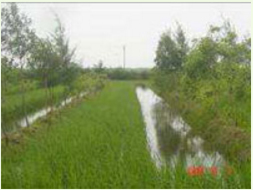 About 75 % of the farm land may be shaped into furrows (2.0m top width × 1.0 m bottom width × 0.75 m depth) and medium ridges (1.0 m top width ×0.75 m height × 2.0m bottom width) with a gap of 3.5m between two consecutive ridges and furrows. Thus, there will be three land situations viz. low land (medium furrow), midland (original farm land) and high land (ridge)
About 75 % of the farm land may be shaped into furrows (2.0m top width × 1.0 m bottom width × 0.75 m depth) and medium ridges (1.0 m top width ×0.75 m height × 2.0m bottom width) with a gap of 3.5m between two consecutive ridges and furrows. Thus, there will be three land situations viz. low land (medium furrow), midland (original farm land) and high land (ridge)
The furrows can be used for rainwater harvesting as well as fish cultivation along with paddy in wet season. In dry season furrows can be used for rice cultivation. The ridges are free from waterlogging in wet season and suitable for cultivation of crops other than rice throughout the year. The original land is used for growing low water requiring.
- Land shaping for farm pond:
The water balance analysis shows considerable scope for conservation of excesses rain water in on-farm reservoir (OFR). 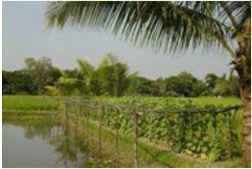 Soil water balance model developed for rainfed rice cultivation showed that about 20% of watershed/ farm area may be converted to OFR (Fig. 12) to harvest excess rain water for utilizing to grow crops in rabi/summer, supplemental irrigation in kharif and freshwater aquaculture. The dug-out soil was used to raise the land to form high and medium land situations for growing multiple crops including
Soil water balance model developed for rainfed rice cultivation showed that about 20% of watershed/ farm area may be converted to OFR (Fig. 12) to harvest excess rain water for utilizing to grow crops in rabi/summer, supplemental irrigation in kharif and freshwater aquaculture. The dug-out soil was used to raise the land to form high and medium land situations for growing multiple crops including
- Land Shaping for paddy-cum-fish cultivation:
 Trenches of about 3 m width X 1.5 m depth are dug around the field with a ditch of 6m X 6m X 3m(depth) at one corner. The excavated soil is used for making dikes of about 3 m width X 1.5 m high around the field to protect the fishes to be grown in paddy-cum-fish cultivation (Fig. 13). During kharif paddy-cum fish is grown on the original low land and vegetables on the dikes.
Trenches of about 3 m width X 1.5 m depth are dug around the field with a ditch of 6m X 6m X 3m(depth) at one corner. The excavated soil is used for making dikes of about 3 m width X 1.5 m high around the field to protect the fishes to be grown in paddy-cum-fish cultivation (Fig. 13). During kharif paddy-cum fish is grown on the original low land and vegetables on the dikes.
During rabi/summer low water requiring field crops & vegetables are continued to be grown on the dikes, and low water rquring crops on the original land with live saving irrigation given with rain water harvested furrows. Otherwise the original lands may also be used for brackish water fish cultivation. At the end of the summer season the brackish water is drained out with the help of pre-monsoon rains. The land is again used for Paddy-cum-fish cultivation.
- Crop Improvement and diversification
Crop varieties: Eradication of soil salinity and amelioration require a large expenditure, which is difficult to afford. Therefore, manipulation of the genotypes is used to suit the existing soil and water constraints. The salt tolerant high yielding varieties of rice and other crops developed/ identified by this station. The promising rice varieties developed/identified for rabi/summer and kharif seasons are given in Table 1&2.
Table 1. Improved varieties of rice for rabi/summer
| Salinity | Varieties |
| Level* | |
| Low | CSR 4,Canning 7, Ratna, Khitis, Rasi, Body, IR 7634, IR 75395 |
| Medium | CSR 4, Canning 7, CST 7-1, CSRC(S) 7-10-4-0-1,Lalminikit (WGL 20471) |
| Bidhan 2, Annada, Lalat, CSRC(S) 39-1-B-2, CSRC(S) 47-7-B-B-1 |
* Soil salinity (ECe,dS m-1) : Low < 6.0, medium 6.0-8.0
Table 2. Improved varieties of rice for kharif
| Water | Soil | Varieties |
| Regimes
Up to 15 cm |
Salinity
Medium to high |
Early: CSR4, Canning 7, IET 1444, CSRC(S)7-10-2-0 |
| (up land)
15-30 (Shallow Water) |
Low To medium | Medium: CST7-1, Jaya, CSR 1, CSR 2, CSR 3
Medium: CSR 6, SR26B, CS9-1-30, Dudheswar, CSRC(S)21-2-5-B-1-1 Late: NC1281, NC678, Matla , Hamilton, Najani, Jhingasail, C300, BD50-11, C340-22-17, Gavir Saru, Gopal Bhog,C300, BD50-11, C340-22-5 |
| 30-50 cm(semi-Deep water) | Low To Medium | Medium: CSRC (S) 2-1-7, SR 26B,CSR6, IR 16294, CS 9-1-30, Amalmana (CSRC(S) 7-1-4), Geetanjali, SR 26B, Pankaj, Sabita, Patnai 23
Late: C300, BD50-11, C340-22-17, C340-22-5, NC 1281, Matla, Hamilton, Asfal, Gavir Saru, NC 678 |
| Acid Saline Soils (pH 4.0-5.5), salinity Medium | Medium: Mahsuri, Canning 7, SR 26B, K.D.Mail | |
| Flash Floods | CAC615, CSR6, SR26B, Swarna Sub-1 |
* Early, Medium, Late indicate duration of <120, 120-140, >140 days, respectively
Salt tolerant vegetable, fruit, fodder and agroforestry crops:
-
Coix was identified as a fodder crop tolerant to waterlogging and high salinity.
-
Chilli can be grown profitably at soil salinity (ECe) up to 7 dSm-1 and cotton up to 13 dSm-1.
-
Guava and particularly sapota (Fig.14) are suitable fruit crops under high salinity.
-
Sweet potato can be grown under high salinity.
-
Suitable agroforestry species that can be grown after some land shaping are:
Eucalyptus sps., Acacia auriculiformis, Casuarina sps., Heritiera fomes, Brugeria gymnorhiza & Xylocarpus mekongensis
Suitable mangrove forest species identified for non-tidal coastal saline soils are:
-
Avicennia, Xylocarpus, Excoecaria, Brugaria and Heretiera
-
Spices like Fennel, Nijella sativa and coriander can be grown in the salt affected coastal land.
-
Suitable aromatic crops are Cymbopogon flexuous, Alovera sp., Cymbopogon flexuous and Cymbopogon martini.
-
Rauwolfia serpentina L. (Swarpagandha ), Isabgol (Plantago Ovata) were identified as promising medicinal plants for coastal region
Crop calendar: 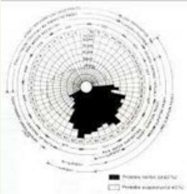 A crop calendar (Fig.14) has been devised accommodating a large number of crops considering weather, soil salinity, water requirement, etc. for crop production throughout the year. The crops to be cultivated in a perticuler area can be selected with the help of the crop calendar and depending on the soil salinity and irrigation water available
A crop calendar (Fig.14) has been devised accommodating a large number of crops considering weather, soil salinity, water requirement, etc. for crop production throughout the year. The crops to be cultivated in a perticuler area can be selected with the help of the crop calendar and depending on the soil salinity and irrigation water available
Criteria identified for salt tolerance of crops:
-
Lower Na/K ratio in plant tissue
-
Smaller variation in stomatal frequency
-
Lesser variation of leaf water potential with salt stress
-
Presence of epidermal hairs or trichomes
-
Higher dehydrogenase activity and stomatal resistance with increased salinity.
-
A weak band of high molecular weight of 90 Kda polypeptide.
For more detailed information please contact:
Head, CSSRI, RRS, Canning Town,
South 24-Parganas, West Bengal, India, PIN-743329,
Telephone : 03218-255241/255085, Fax: 03218-255084,
E-mail: cssri[dot]canning[at]gmail[dot]com
Web: www.cssri.org


